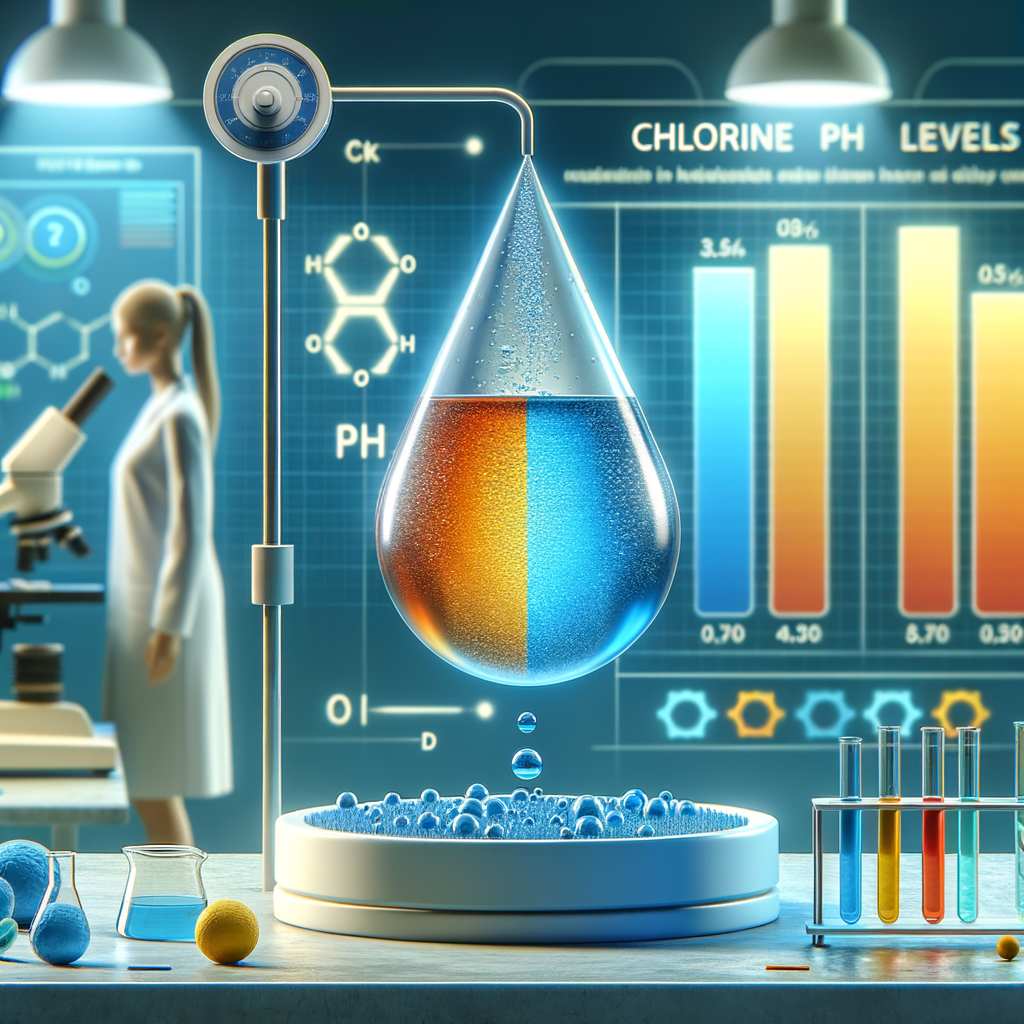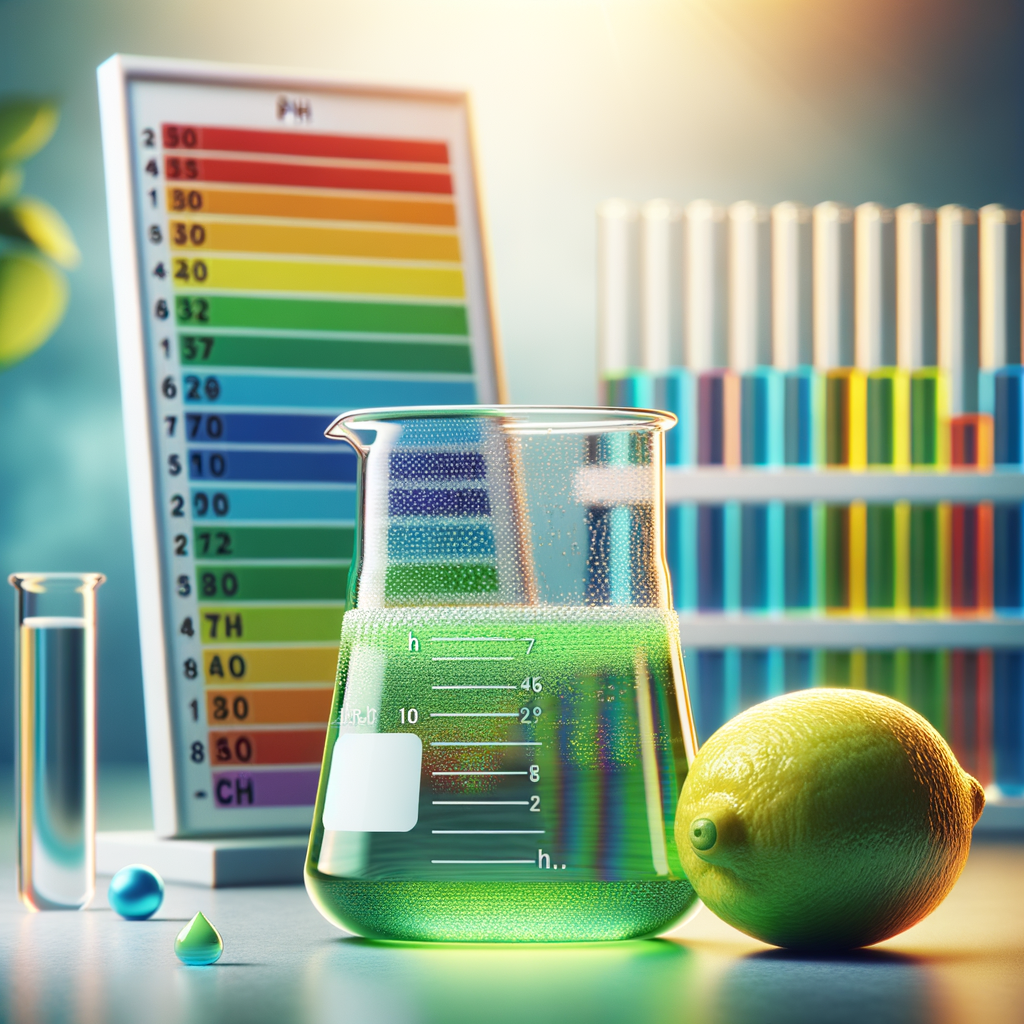
“chlorine ph: Balancing Purity and Safety in Every Drop.”
Table of Contents
Introduction
chlorine ph refers to the measure of acidity or alkalinity in a solution where chlorine is present, typically in water treatment processes such as swimming pools, drinking water, and wastewater management. The pH level is crucial because it affects the efficacy of chlorine as a disinfectant. Chlorine is most effective at a pH range of 7.2 to 7.8, where it exists predominantly as hypochlorous acid (HOCl), a potent antimicrobial agent. Outside this range, chlorine’s disinfecting power diminishes, and it can form less effective compounds like hypochlorite ions (OCl-). Maintaining the correct pH balance ensures optimal chlorine performance, safeguarding public health by effectively controlling harmful microorganisms.
Common Mistakes In Managing Chlorine And pH In Swimming Pools

Maintaining the proper balance of chlorine and pH in swimming pools is crucial for ensuring both the safety and comfort of swimmers. However, many pool owners and operators often make common mistakes in managing these essential elements, leading to a range of issues from ineffective sanitation to swimmer discomfort. Understanding these pitfalls and how to avoid them can significantly enhance the swimming experience while safeguarding health.
One frequent mistake is the overuse or underuse of chlorine. Chlorine is a powerful disinfectant that kills harmful bacteria and pathogens, but its effectiveness is highly dependent on maintaining the correct concentration. Over-chlorination can lead to skin and eye irritation, as well as a strong, unpleasant odor. Conversely, under-chlorination can result in insufficient disinfection, allowing harmful microorganisms to thrive. To avoid these extremes, it is essential to regularly test chlorine levels using reliable testing kits and adjust the dosage accordingly. Consistent monitoring ensures that chlorine levels remain within the recommended range of 1 to 3 parts per million (ppm).
Another common error involves neglecting the pH balance of the pool water. The pH level, which measures the acidity or alkalinity of the water, plays a critical role in the effectiveness of chlorine. A pH level that is too high (above 7.8) can reduce chlorine’s ability to sanitize, while a pH level that is too low (below 7.2) can cause corrosion of pool equipment and discomfort for swimmers. Maintaining a pH level between 7.2 and 7.8 is ideal for both chlorine efficiency and swimmer comfort. Regular testing and the use of pH increasers or decreasers can help achieve this balance.
In addition to these primary concerns, pool owners often overlook the importance of stabilizers, such as cyanuric acid, which protect chlorine from being rapidly degraded by sunlight. Without stabilizers, chlorine can dissipate quickly, especially in outdoor pools, necessitating more frequent additions and leading to inconsistent levels. However, it is crucial to use stabilizers judiciously, as excessive cyanuric acid can also reduce chlorine’s effectiveness. Maintaining cyanuric acid levels between 30 and 50 ppm is generally recommended.
Furthermore, the interaction between chlorine and pH is often misunderstood. Some pool owners mistakenly believe that adding more chlorine can compensate for an imbalanced pH, or vice versa. However, these two factors must be managed independently yet harmoniously. For instance, if the pH is too high, adding more chlorine will not improve sanitation; instead, the pH must be adjusted first to ensure chlorine can work effectively. This interdependence underscores the importance of regular, comprehensive testing and adjustments.
Another oversight is the failure to account for the total alkalinity of the pool water, which acts as a buffer for pH stability. Low total alkalinity can cause pH levels to fluctuate widely, making it difficult to maintain a consistent balance. Conversely, high total alkalinity can make it challenging to adjust pH levels. Keeping total alkalinity within the range of 80 to 120 ppm helps stabilize pH and, by extension, chlorine effectiveness.
Lastly, many pool owners do not recognize the impact of environmental factors, such as heavy rainfall, high bather loads, and debris, on chlorine and pH levels. These factors can introduce contaminants and alter water chemistry, necessitating more frequent testing and adjustments. Being proactive in managing these variables can prevent sudden imbalances and ensure a consistently safe and pleasant swimming environment.
In conclusion, effective management of chlorine and pH in swimming pools requires a comprehensive and proactive approach. By avoiding common mistakes such as improper dosing, neglecting pH balance, misunderstanding the role of stabilizers, and overlooking environmental impacts, pool owners can maintain optimal water quality. Regular testing, informed adjustments, and a thorough understanding of water chemistry are essential for ensuring both the safety and enjoyment of all swimmers.
Balancing Chlorine And pH For Optimal Water Quality
Balancing chlorine and pH for optimal water quality is a critical aspect of maintaining safe and healthy water environments, whether in swimming pools, drinking water systems, or industrial applications. Chlorine is widely used as a disinfectant due to its effectiveness in eliminating harmful pathogens, bacteria, and viruses. However, its efficacy is significantly influenced by the pH level of the water. Therefore, understanding the interplay between chlorine and pH is essential for ensuring water quality.
Chlorine, when added to water, forms hypochlorous acid (HOCl) and hypochlorite ion (OCl-), both of which are responsible for its disinfecting properties. The proportion of these two compounds is highly dependent on the pH level of the water. At a lower pH, hypochlorous acid predominates, which is a more potent disinfectant. Conversely, at a higher pH, hypochlorite ion becomes more prevalent, which is less effective in killing microorganisms. Consequently, maintaining an optimal pH range is crucial for maximizing the disinfecting power of chlorine.
The ideal pH range for chlorine to function effectively is typically between 7.2 and 7.8. Within this range, a balance is achieved where hypochlorous acid is sufficiently present to ensure effective disinfection while minimizing the formation of hypochlorite ion. If the pH level falls below 7.2, the water becomes too acidic, which can lead to corrosion of pool equipment and irritation of the skin and eyes of swimmers. On the other hand, if the pH level rises above 7.8, the water becomes too alkaline, reducing the efficacy of chlorine and potentially leading to the formation of scale on pool surfaces and equipment.
To maintain this delicate balance, regular monitoring and adjustment of both chlorine and pH levels are necessary. Pool owners and operators often use test kits or electronic sensors to measure these parameters accurately. When the pH level deviates from the optimal range, chemicals such as muriatic acid or sodium bisulfate can be added to lower the pH, while sodium carbonate or sodium bicarbonate can be used to raise it. Similarly, chlorine levels can be adjusted by adding chlorine-based compounds like calcium hypochlorite, sodium hypochlorite, or chlorine gas.
Moreover, it is important to consider the impact of other factors on chlorine and pH balance. For instance, the presence of organic matter, such as leaves, sweat, and urine, can consume chlorine and necessitate higher doses to maintain effective disinfection. Additionally, environmental factors like sunlight and temperature can influence chlorine stability and pH levels. Ultraviolet (UV) rays from the sun can degrade chlorine, while higher temperatures can accelerate chemical reactions, both of which may require more frequent adjustments.
In conclusion, achieving optimal water quality through the careful balancing of chlorine and pH is a multifaceted process that demands regular attention and precise control. By maintaining the pH within the ideal range of 7.2 to 7.8, the disinfecting power of chlorine can be maximized, ensuring the safety and health of water users. Regular monitoring, appropriate chemical adjustments, and consideration of external factors are all essential components of effective water management. Through diligent efforts, the benefits of chlorine disinfection can be fully realized, providing clean and safe water for various applications.

How pH Levels Affect Chlorine Efficiency In Pools
Maintaining a swimming pool involves a delicate balance of various chemical parameters, among which pH levels and chlorine efficiency are paramount. Understanding how pH levels affect chlorine efficiency in pools is crucial for ensuring water safety and clarity. Chlorine, a widely used disinfectant, plays a vital role in eliminating harmful microorganisms and maintaining a hygienic swimming environment. However, its effectiveness is significantly influenced by the pH level of the pool water.
Chlorine exists in pool water in two primary forms: hypochlorous acid (HOCl) and hypochlorite ion (OCl-). The proportion of these two forms is determined by the pH level. Hypochlorous acid is the more potent disinfectant, capable of killing bacteria and viruses more effectively than hypochlorite ion. At a lower pH, typically around 7.2 to 7.4, a higher percentage of chlorine is present as hypochlorous acid, thereby enhancing its disinfecting power. Conversely, as the pH level rises above 7.4, the concentration of hypochlorous acid decreases, and the less effective hypochlorite ion becomes more prevalent.
To illustrate, at a pH of 7.0, approximately 75% of the chlorine is in the form of hypochlorous acid, while at a pH of 8.0, only about 25% remains as hypochlorous acid. This significant reduction in the active form of chlorine at higher pH levels underscores the importance of maintaining an optimal pH range. When the pH level is too high, chlorine’s ability to sanitize the pool water diminishes, leading to potential health risks for swimmers and the proliferation of algae and bacteria.
Moreover, pH levels also impact the comfort of swimmers. Water with a high pH can cause skin and eye irritation, while a low pH can lead to corrosion of pool equipment and surfaces. Therefore, balancing the pH not only ensures chlorine efficiency but also contributes to the overall well-being of pool users and the longevity of the pool infrastructure.
In addition to pH, other factors such as temperature, sunlight, and the presence of contaminants can affect chlorine efficiency. However, pH remains one of the most controllable and influential parameters. Regular testing and adjustment of pH levels are essential practices for pool maintenance. Pool owners and operators should use reliable test kits to monitor pH levels frequently and make necessary adjustments using pH increasers or decreasers.
Furthermore, understanding the relationship between pH and chlorine efficiency can lead to more cost-effective pool management. When pH levels are maintained within the optimal range, less chlorine is required to achieve the desired sanitizing effect. This not only reduces chemical costs but also minimizes the environmental impact associated with excessive chlorine use.
In conclusion, the efficiency of chlorine as a disinfectant in swimming pools is intricately linked to the pH level of the water. Maintaining a pH range of 7.2 to 7.4 ensures that a higher proportion of chlorine is in its most effective form, hypochlorous acid, thereby enhancing its ability to keep the pool water clean and safe. Regular monitoring and adjustment of pH levels are essential for optimal chlorine performance, swimmer comfort, and the preservation of pool infrastructure. By understanding and managing pH levels, pool owners can ensure a healthier and more enjoyable swimming experience.
Understanding The Relationship Between Chlorine And pH Levels
Chlorine and pH levels are two critical factors in maintaining the safety and effectiveness of swimming pools, water treatment systems, and various industrial processes. Understanding the relationship between chlorine and pH levels is essential for ensuring optimal water quality and preventing potential health hazards. Chlorine, a powerful disinfectant, is widely used to eliminate harmful microorganisms in water. However, its efficacy is significantly influenced by the pH level of the water. The pH scale, which ranges from 0 to 14, measures the acidity or alkalinity of a solution, with 7 being neutral. When the pH level of water is too high or too low, it can affect the performance of chlorine, rendering it less effective in killing bacteria and other pathogens.
To begin with, it is important to recognize that chlorine exists in different forms depending on the pH level of the water. When chlorine is added to water, it forms hypochlorous acid (HOCl) and hypochlorite ion (OCl-). Hypochlorous acid is the more potent disinfectant, capable of penetrating and destroying the cell walls of microorganisms. The proportion of hypochlorous acid to hypochlorite ion is highly dependent on the pH level. At a lower pH, more hypochlorous acid is present, enhancing the disinfecting power of chlorine. Conversely, at a higher pH, the concentration of hypochlorous acid decreases, and the less effective hypochlorite ion predominates.
For instance, at a pH level of 7.5, approximately 50% of the chlorine is in the form of hypochlorous acid, while the other 50% is in the form of hypochlorite ion. As the pH level rises to 8.0, the proportion of hypochlorous acid drops to about 20%, significantly reducing the disinfecting capability of chlorine. Therefore, maintaining an optimal pH range, typically between 7.2 and 7.6, is crucial for maximizing the effectiveness of chlorine in water treatment.
Moreover, the relationship between chlorine and pH levels extends beyond disinfection efficacy. The pH level also affects the stability and longevity of chlorine in water. At higher pH levels, chlorine tends to degrade more rapidly, leading to increased consumption and higher operational costs. Additionally, high pH levels can cause scaling and cloudiness in swimming pools, while low pH levels can lead to corrosion of pool equipment and irritation of the skin and eyes of swimmers.
To manage the interplay between chlorine and pH levels effectively, regular monitoring and adjustment are necessary. Pool operators and water treatment professionals often use test kits and automated systems to measure pH and chlorine levels accurately. When pH levels deviate from the optimal range, chemical additives such as muriatic acid or sodium bisulfate can be used to lower pH, while sodium carbonate or sodium bicarbonate can be employed to raise pH levels. By maintaining the appropriate balance, the disinfecting power of chlorine can be optimized, ensuring safe and clean water for various applications.
In conclusion, the relationship between chlorine and pH levels is a fundamental aspect of water quality management. The effectiveness of chlorine as a disinfectant is highly dependent on the pH level of the water, with lower pH levels favoring the formation of the more potent hypochlorous acid. Additionally, pH levels influence the stability and consumption of chlorine, as well as the overall condition of water systems. Through diligent monitoring and adjustment, the optimal balance between chlorine and pH levels can be achieved, promoting safe and effective water treatment practices.
Q&A
1. **What is the ideal pH range for chlorine to be most effective in swimming pools?**
– The ideal pH range for chlorine to be most effective in swimming pools is between 7.2 and 7.6.
2. **How does pH affect the efficacy of chlorine in water?**
– If the pH is too high (above 7.8), chlorine becomes less effective at sanitizing. If the pH is too low (below 7.2), chlorine can become too aggressive and cause irritation.
3. **What happens to chlorine levels when the pH is too high?**
– When the pH is too high, chlorine becomes less effective, leading to potential growth of bacteria and algae.
4. **What chemical can be used to lower the pH in a pool if it is too high?**
– Muriatic acid (hydrochloric acid) or sodium bisulfate can be used to lower the pH in a pool.
Conclusion
Chlorine, a highly reactive halogen, significantly impacts pH levels in water. When dissolved, it forms hypochlorous acid (HOCl) and hypochlorite ions (OCl-), both of which are effective disinfectants. The pH level of the water influences the balance between these two forms, with lower pH favoring HOCl, which is more effective at disinfection. Therefore, maintaining an optimal pH range is crucial for maximizing chlorine’s efficacy in water treatment processes.

